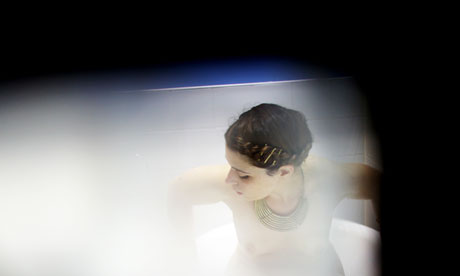Venues and festivals that nurture emerging work must offer artists protection as well as a platform, says Jo Crowley

Exposure is one thing
for Mark Wallinger's Diana at the National, quite another for new and
emerging artists' work.
During the last week of the 2012 Edinburgh Festival Fringe
I sat in a respected venue, watching a promising ensemble of emerging
artists presenting their new show. The artists were clearly talented and
highly skilled. The audience was typical of Edinburgh – peers, punters,
critics and programmers, united in their support and curious to see
what this talented young company had to offer. Myriad venues, festivals
and funders of national and international standing had supported the
show.
Expectation was high. However, there was a problem – the show wasn't finished.
Now don't get me wrong. I have repeatedly seen the benefits of developing artistic work in dialogue with audiences. Letting evolving work breathe through work-in-progress and scratch performances
can be enormously beneficial to some artists with regards to the
quality of the artistic work they create and, ultimately, to the final
experience offered to audiences.
But is Edinburgh, the biggest arts festival in the world, the largest
performance showcase on earth, really the right context to present
developing work?
In this instance, the show in question needed
substantial dramaturgical attention and technical development. Reading
the small print on the programme, you could deduce the show was still in
development. However, this was not communicated on venue, company or
fringe publicity. I witnessed a series of venue and festival programmers
bemused as to why they were watching an unfinished piece, questioning
why this hadn't been communicated and, perhaps most disturbingly,
rejecting future programming of the show on the basis of a
work-in-progress showing.
This prompted me to consider the
potential repercussions of exposing developing work too early or in the
wrong context. If this emerging work is being supported by established
organisations, why is it being exposed so publicly in the wrong context?
How supportive are these organisations actually being of the artists,
ensembles and companies involved?
Venues, festivals and platforms
that support emerging and developing work need to have a thorough and
informed awareness that exposing work at the wrong time, in the wrong
context, or to the wrong audience can cripple a project and have major
repercussions on an artist's future work, as well as inhibiting their
ability to grow audiences, attract funding and develop future touring
and programming.
Supporting emerging talent and collaboration,
particularly in the current climate, must be about more than just
providing money, space and resources. Surely it must also encompass a
fundamental commitment to nurturing, and to having informed and honest
dialogues about appropriate contexts and platforms for presenting
evolving work? And surely to be most productive these dialogues should
involve a series of perspectives – with contributions from peers and
audiences.
If we can ensure this, then perhaps we might just find a
way in which emerging artists can grow and survive even in these
challenging times. Most importantly, we'll see the work of visionary
emerging artists being realised, and the best possible future
experiences for audiences achieved.
No comments:
Post a Comment